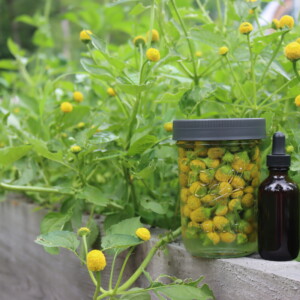
Spilanthes Tincture
A spilanthes tincture is a homemade herbal remedy that's easy to make with just a few ingredients.
Equipment
Ingredients
- Spilanthes dried or fresh
- Neutral Spirit such as vodka*
Instructions
- Begin by filling a clean mason jar about 3/4 full with fresh Spilanthes or 1/2 full with dried Spilanthes. If you're using dried plant material, it's often available at herbal supply stores.
- Pour your chosen alcohol (such as vodka, brandy, or whisky) over the Spilanthes, ensuring the plant material is fully submerged. The alcohol should cover the herbs by at least an inch. It’s important to use a high-proof alcohol (60 proof or higher) for proper extraction and preservation.
- Screw the lid on tightly, then shake the jar gently to mix the plant material with the alcohol. Store the jar in a cool, dark place, away from direct sunlight. Let it sit for 6 to 8 weeks to allow the Spilanthes to infuse.
- Every few days, give the jar a gentle shake to help the extraction process. Keep an eye on the alcohol level and top it off with more alcohol if necessary to ensure the plant material stays fully submerged.
- After the 6 to 8-week infusion period, it’s time to strain the tincture. Set up a funnel lined with cheesecloth over a clean, dark glass bottle. Carefully pour the liquid and plant material through the funnel, pressing down on the plant matter to extract as much of the liquid as possible.
- Once strained, label the tincture with the plant name, date of preparation, recommended dosage, and any suggested uses. Store it in a cool, dry place away from light. Tinctures made with alcohol have a long shelf life if stored properly.
Notes
Alcohol Choices
Vodka is the most commonly used alcohol for tinctures due to its neutral flavor, but other spirits like brandy or whisky work well too. Make sure the alcohol is at least 60 proof to ensure proper extraction and preservation. Do not use denatured alcohol or isopropyl alcohol for tinctures, as these are toxic and unsafe for consumption.Yield
The amount of tincture you yield will depend on whether you're using fresh or dried Spilanthes. Fresh herbs will typically yield slightly more tincture than the amount of alcohol you add. Dried herbs absorb some alcohol, leading to a slightly reduced yield. For a quart jar, use 2-3 cups of alcohol, and for a pint jar, about 1 to 1.5 cups. Always ensure the plant material remains fully submerged to prevent oxidation or spoilage.To make an alcohol-free glycerite tincture (glycerite)
If you prefer to avoid alcohol, you can make an alcohol-free glycerite tincture using vegetable glycerin. Simply cover the dried Spilanthes with a mixture of 3 parts glycerin to 1 part distilled water. For fresh Spilanthes, use only glycerin (no water). Glycerites need to be shaken daily as they infuse. Once ready, strain and bottle as you would with an alcohol tincture. Tried this recipe?Let us know how it was!